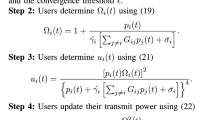Abstract
This paper presents uplink power control in cellular radio systems from an economic point of view. A utility function is defined for each mobile user, which reflects the user's preference regarding the carrier-to-interference ratio (CIR) and the transmitter power. We observe that, on one hand, mobile users prefer to transmit at a lower power for a fixed CIR. On the other hand, for a given transmitter power, users prefer to obtain a better CIR. Based on this observation, we make two fundamental assumptions about the utility function. We formulate the uplink power control problem as a non-cooperative N-person game. Under the two assumptions that we make about the utility function, there exists a Nash equilibrium. To show the generality of the framework, we study one special case by defining the utility as a linear function. This model encompasses many of the widely studied power control problems. A more general case is also studied by defining utility as an exponential function. This paper establishes a general economic-based framework for studying resource management in wireless networks and points out new research directions.
Similar content being viewed by others
References
J.M. Aein, Power balancing in system employing frequency reuse, COMSAT Technical Review 3 (1973).
K.J. Arrow, Aspects of the Theory of Risk-Bearing (Yrjo Jahnsson Saatio, Helsinki, 1965).
J.P. Aubin, Mathematical Methods of Game and Economic Theory (North-Holland, Amsterdam, 1979).
G. Debreu, Theory of Value: An Axiomatic Analysis of General Equilibrium (Yale University Press, New Haven, NH, 1959).
G.J. Foschini and Z. Miljanic, A simple distributed autonomous power control algorithm and its convergence, IEEE Transactions on Vehicular Technology 42 (1993).
T. Fujii and M. Sakamoto, Reduction of cochannel interference in cellular systems by intra-zone channel reassignment and adaptive transmitter power control, in: Proc. IEEE Vehicular Technology Conference, VTC' 88 (1988).
S. Grandhi, R. Vijayan, D.J. Goodman and J. Zander, Centralized power control for cellular radio systems, IEEE Transactions on Vehicular Technology 42 (1993).
S. Grandhi, R. Vijayan and D.J. Goodman, Distributed power control for cellular radio systems, in: Proc. 30th Annual Allerton Conf. Commun., Control, Computing, Monticello, IL (1993).
H. Ji, An economic model for uplink power control in cellular radio systems, in: Proceedings of the 33rd Allerton Conference on Communication, Control, and Computing, Monticello, IL (1995).
H. Ji and C.Y. Huang, Pricing and power control in cellular radio systems, in: Proceedings of the 30th Annual Conference on Information Sciences and Systems (CISS), Princeton, NJ (1996).
H. Ji, J.Y. Hui and E. Karasan, GoS-based pricing and resource allocation for multimedia broadband networks, in: Proceedings of INFOCOM' 96, San Francisco, CA (1996).
H.J. Meyerhoff, Method for computing the optimum power balancing in multibeam satellite, COMSAT Technical Review 4 (1974).
D. Mitra, An asynchronous distributed algorithm for power control in cellular radio systems, in: Fourth WINLAB Workshop on Third Generation Wireless Information Networks, New Brunswick, NJ (1993).
J. Nash, Equilibrium points in n-person games, Proc. Nat. Acad. Sci. U.S.A. 36 (1950).
R.W. Nettleton and H. Alavi, Power control for spread-spectrum cellular mobile radio system, in: Proc. IEEE Vehicular Technology Conference, VTC' 83 (1983).
J. von Neumann and O. Morgenstern, Theory of Games and Economic Behavior (Princeton University Press, Princeton, NJ, 1945).
R. Yates and C.Y. Huang, Integrated power control and base station assignment, IEEE Transactions on Vehicular Technology 44 (1995).
R. Yates and C.Y. Huang, Constrained power control and base station assignment in cellular radio systems, IEEE/ACM Transactions on Networking (1996).
R. Yates, A framework for uplink power control in cellular radio systems, IEEE Journal on Selected Areas in Communications (1996).
J. Zander, Performance of optimum transmitter power control in cellular radio systems, IEEE Transactions on Vehicular Technology 41 (1992).
J. Zander, Distributed cochannel control in cellular radio systems, IEEE Transactions on Vehicular Technology 41 (1992).
J. Zander, Transmitter power control for co-channel interference management in cellular radio systems, in: Fourth WINLAB Workshop on Third Generation Wireless Information Networks, New Brunswick, NJ (1993).
Author information
Authors and Affiliations
Rights and permissions
About this article
Cite this article
Ji, H., Huang, CY. Non-cooperative uplink power control in cellular radio systems. Wireless Networks 4, 233–240 (1998). https://doi.org/10.1023/A:1019108223561
Issue Date:
DOI: https://doi.org/10.1023/A:1019108223561




